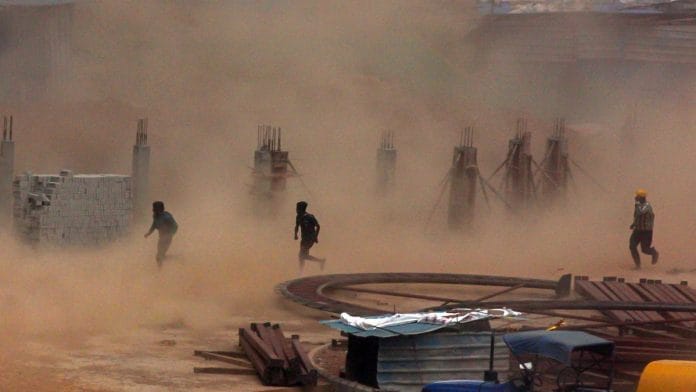New Delhi: Over the past week, severe dust storms have swept through New Delhi and Mumbai, resulting in nearly 20 deaths. In Mumbai alone, 14 people died Monday when a billboard collapsed in Ghatkopar. Both regions experienced high winds of around 80-90 kmph, accompanied by thunder and light rain.
Our forecasting systems are still not close to predicting dust storms and setting up early warning systems. This is due to the localised and brief nature of dust storms and lack of Doppler radars that can track the meteorological conditions that accompany dust storms.
Dust storms are similar to thunderstorms except they occur when the base of the cloud is at a higher level from the ground and there’s little moisture in the air. The extremely high winds lift up dust and soil from the ground, and these kinds of dust storms are quite common in arid and semi-arid regions. Mahesh Palawat, of Skymet Weather Forecasting, said that dust storms are likely in north-west India, Delhi, and Punjab in April and May. “The dust storm in Mumbai, however, was a rare occurrence because coastal regions usually don’t see dust storms of this intensity,” he added.
Both the Mumbai and Delhi dust storms were not entirely forecasted by the India Meteorological Department (IMD), with the emergency ‘nowcasts’ (short-term forecasts) by the IMD arriving a little while after dust storm conditions had already begun in some regions. In the daily forecast press releases, the IMD had only predicted thunderstorms with a wind speed of 30-40 kmph, and not dust storms with over 80 kmph wind speed.
The extremely strong winds and increased presence of dust particles in the air make dust storms very dangerous for both humans and livestock. Currently, our systems are equipped to predict dust storms only 2-3 hours in advance through IMD’s nowcasts, which are issued to alert citizens of any sudden changes in the weather, the intensity of which is indicated through colours — red for warning, orange for alert, yellow for watch and green for no warning. Nowcasts use data from Doppler radars, which can track cumulonimbus clouds — thunderclouds that produce rain, hail, and lightning and which are created through convection.
However, India only has around 37 Doppler radars across the country, which inhibits their ability to forecast events like thunderstorms. “To be able to accurately predict how dust storms will occur and exactly when and where they’ll occur, we need to increase the density of these radars,” said Palawat.
According to the IMD Director General M. Mohapatra, however, India is sufficiently placed to predict dust storms and their intensity. “Doppler radars and satellites are only used to monitor dust storms, but we have forecast models in place that allow us to predict them too,” said Mohapatra. “Of course, dust storms have a very short life period of about 2-3 hours which is why cannot predict them 7 days or 10 days in advance,” he added.
Also read: Illegal wildlife trade persistent & pervasive, warns UN crime agency, calls for urgent action
Predicting dust storms
Predicting these events also has another set of challenges, apart from Doppler radars. According to Rajeevan Nair, former secretary of the ministry of earth sciences, dust storms are extremely localised events and are short in duration which makes forecasting all the more difficult.
The IMD’s press releases on 8 and 10 May had predicted thunderstorms, gusty winds and lightning over Peninsular India, especially Maharashtra’s Marathwada region until 12 May. It had also predicted thunderstorms over Northwest India on 10 May, which is when Delhi was hit by a dust storm, but only forecasted 30-40 kmph wind. However, said Nair, this is the extent to which our systems are equipped to predict dust storms of this kind.
“The accuracy with which we can predict cyclones or other wind activity is not there in our prediction of dust storms. Most dust storms start and dissipate within a few hours, and do not have a build-up that we can track,” he explained. “We can predict the possibility of dust and thunderstorms 24 hours in advance, but cannot say when they will hit or which specific area they will target.”
A 2021 study by the Asian and Pacific Centre for the Development of Disaster Information Management, titled ‘Sand and Dust Storm Risk Assessment in Asia and the Pacific’, found that over 500 million people in India are exposed to poor air quality because of dust storms, and these storms are expected to increase due to rise in droughts in parts of Asia as a result of climate change.
IMD’s Mohapatra, though, said that dust storms occur in most arid countries like Iran and Afghanistan, and even the one in Mumbai on 13 May was not uncommon. “Mumbai’s dust storm was accompanied by rain and thunder too, which are classic signs of a thunderstorm. This is the summer season which is ripe for dust storms, and because Mumbai is a coastal zone there was obviously rain after. Dry dust storms mainly occur in Delhi and Rajasthan, as we saw last week,” said Mohapatra.
Dr Anjal Prakash, a clinical associate professor at Indian School of Business explained how dust storms are extremely harmful to both humans and livestock because of the risk of respiratory and cardiovascular diseases. “The abrasive nature of dust particles can irritate the eyes and skin of livestock, leading to discomfort and decreased productivity. Dust storms can also contaminate water and forage sources, further compromising our health and well-being,” he said.
He explained that in the future there needs to be changes not just in predicting dust storms but also in being able to mitigate them. “Preventing dust storms involves implementing land management practices to reduce soil erosion, such as afforestation, maintaining ground cover, and implementing windbreaks,” said Prakash.
(Edited by Zinnia Ray Chaudhuri)






